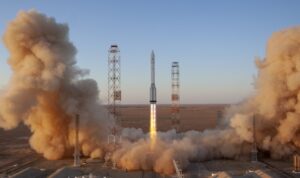Eastern carrying the Multipurpose Laboratory Module, or Nauka. The module separated from the rocket’s upper stage about nine and a half minutes after launch. Both Roscosmos and NASA said that Nauka deployed its solar arrays and navigational antennas shortly after separation.
Neither agency has provided additional updates on the status of Nauka, but Russian industry sources, posting online, claimed that the module suffered several problems after reaching orbit. Those problems included the inability to confirm that an antenna and docking target deployed as expected, as well as issues with infrared sensors and thrusters. It wasn’t immediately clear how serious the problems were and if they would affect plans for docking.
Nauka, Russian for “science,” is the first module (excluding airlocks and docking adapters) added to the ISS since the Bigelow Expandable Activity Module in 2016. The module, 13 meters long and weighing more than 23,000 kilograms at launch, includes crew accommodations, attitude control systems for the station, research facilities and cargo stowage. Attached to the exterior of the station is the European Robotic Arm by the European Space Agency, a manipulator 11 meters long designed to service the Russian segment of the station.
Nauka will slowly approach the station, docking with the Zvezda module on July 29. It will take the place of the Pirs airlock module, added to the station in 2001. A Progress cargo spacecraft will remove Pirs from the station July 23 and later perform a destructive reentry.
Development of Nauka has followed a long, tortured path. Roscosmos originally proposed launching the module in 2007, but extensive technical issues pushed back the launch repeatedly, raising doubts that the module would ever launch. Those delays included problems with the module’s propulsion system that required its replacement.
The continued effort by Roscosmos to finish and launch Nauka, though, has given NASA leadership confidence that they intend to remain a part of the ISS program. Earlier this year Russian officials suggested they might end their participation on the ISS as soon as the mid-2020s to focus their resources on a Russian space station.
“I was quite concerned because of these comments that were coming out of Russia. Were they going to about-face and break the partnership we’ve had?” NASA Administrator Bill Nelson said at a June 23 House Science Committee hearing. He said his concerned faded after several discussions with Dmitry Rogozin, head of Roscosmos.
He also cited the upcoming launch of Nauka. “Why would they be doing that and then, in just a few years, abandon it? It just didn’t make sense,” he said. “I think we’re going to see continued cooperation.”
The launch of Nauka came a few hours after astronauts relocated a Crew Dragon spacecraft on the ISS. Astronauts Shane Kimbrough, Megan McArthur, Akihiko Hoshide and Thomas Pesquet boarded the spacecraft for the maneuver from one docking port on the Harmony module to another. The maneuver started at 6:45 a.m. Eastern with undocking from the forward docking port and ended with docking to the zenith docking port 50 minutes later.
The maneuver frees up the forward port on Harmony for the arrival of a Boeing CST-100 Starliner spacecraft at the station on an uncrewed test flight called Orbital Flight Test (OFT) 2. The forward docking port is easier for spacecraft to approach, hence the maneuver of the Crew-2 Crew Dragon spacecraft to open that port.
The OFT-2 mission is scheduled to launch July 30 from Cape Canaveral, Florida, on a United Launch Alliance Atlas 5. A flight readiness review to confirm that schedule will take place July 22.



